| Uni
Models (UM) of Ukraine produces several versions of the later Panzer
III (i.e. Ausf. H, J, L, M, N and Bergepanzer). These kits are sharing
four out of the five sprues, while the fifth one bears the parts necessary
for the specific version. That means that the modeler will end with
a lot of spare parts, as well as that most of the following comments
are applicable to all Pz.Kpfw. III kits produced by UM.
Before we start, some notes:
• I am not an expert in German armor, so I compared this kit
mainly with the Revell’s Ausf. L and Dragon’s Ausf. J.
Other sources that I have used are mentioned at the end of the preview.
• I have to apologize for the quality of the photographs (I
am a notoriously bad photographer). For better photographs of the
kit’s contents, I suggest you to visit Henk
of Holland’s site.
What
is in the box ?
The side-opening has the artwork of a DAK Ausf. H on top, while on
its back there are drawings of one (generic) vehicle in Dunkelgrau.
The kit consists of five sprues with a total of 235 parts. Out of
them, 190 are suited for the Ausf. H, while the rest belong to those
other versions of Pz.Kpfw. III the company produces. All five sprues
are packed in a cellophane bag. In a zip lock bag there is a small
photo etched sheet and the (quite large) decal sheet. Sprue “A”
(there are two of them) is mainly dedicated to the suspension and
tracks, while sprue “D” is unique in this kit and contains
the parts necessary for an Ausf. H. The other two sprues are common
in all UM’s Pz.Kpfw. III kits (and actually provide a lot of
useful spare parts).
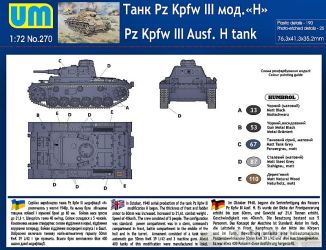
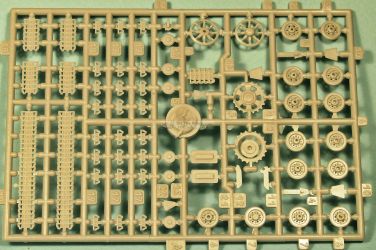
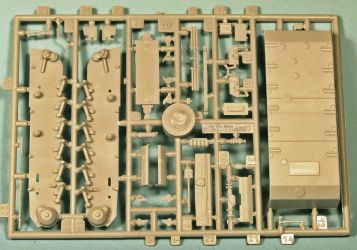
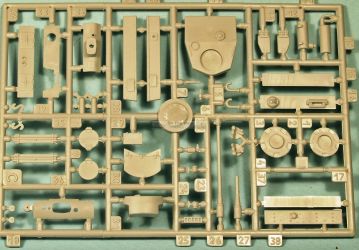


Dimensions
Compared with the above mentioned kits, as both companies are well
reputed for accuracy, the UM offering is on par with them. If there
is any size difference this is not noticeable with the bare eye, so
I assume that this kit is rather correct in scale. Furthermore, I
reduced a 1/35 scale drawing and found no difference.
Lower
hull and suspension
The lower hull is well made and with enough detail on the bottom.
The wheels are also well made and correct for the scale. There are
two problems though, that will embarrass the builder: First, the wheels
do not have the usual (and rational) arrangement of “peg and
hole”, but there are holes in both the inner and outer ones.
This makes the alignment of the wheels fairly difficult and affects
the stability of the construction (surprisingly the return rollers
are “normal”). Second, the lower hull does not have any
guides to be glued with the sides, so the alignment and stability
is dubious as well. As of detail, the escape doors and the shock absorbers
are provided separately and are well made. The first of the return
rollers is provided with a separate base, so it can be placed either
in equal or in unequal spacing with the other two (I suppose that
they had in mind to produce an earlier version – or perhaps
this is necessary for their StuGs – with which they share several
parts). The idlers are beautifully done and correct in size. With
the sprocket there is a problem. Correct in shape and size, they are
attached to the sprue in four points, while the sprue itself runs
on the sprocket. This means that it is almost impossible to get the
sprockets out of the sprue, without damaging them. In the rear of
the lower hull, there are the exhausts (using a saw is highly recommended
here). Holes have to be drilled in order to attach them to the rear
armor. The exhausts themselves are rather simplified compared with
the other kits, but they are acceptable. Not surprisingly they are
not drilled at their end. The intake mesh is provided, but this piece
is fairly crude and better to be replaced. Finally, four pieces are
provided for the rear towing shackles.
Upper
hull
There is a lot of well defined detail in this part. The brake access
doors are not provided separately, but they are correct for the type.
The appliqué armor characteristic for Ausf. Hs, is provided
in two pieces with nice detail. The superstructure’s appliqué
armor contains also the hull machine gun’s mount, the driver’s
visor and has holes for his periscope (better to be further drilled).
All tools and tool boxes are provided separately and are well done.
The (separate) fenders have no anti-slip surface. The early type front
towing shackles are provided in two pieces each. There are also two
pieces to be attached in the lower hull’s corners (the later
ones that actually were hull’s extensions and were drilled,
are not suitable for an Ausf. H). The rear convoy light, the horn,
the Notek light and the headlights are provided separately too. There
is a catch though: Again there is no “peg and hole” arrangement,
thus it is fairly easy to lose these parts during the construction
(believe me: I learned it the hard way!!!!!!). In the rear part of
upper hull, there are three rectangular bases, to accommodate the
engine’s armored covers (the kit contains seven such covers).
Also bases are provided to accommodate the two rear ones, but these
are most suitable for the early tropical covers (which are also provided,
but are rather small). If you want to build an initial production
Ausf. H, all these bases have to be sawed off. The air intake grills,
are provided in photo etched and are superb. The final end of the
upper hull is provided as a separate piece and includes the starter
crank’s cover and the (correct for the type) smoke candle rack,
with its armored cover. Photo etched covers for the headlights are
provided. The kit’s major omission concerns the brake cooling
covers, where (for some unknown reason) the company missed to mold
or provide their spherical tops.
The
turret
The turret consists of three main parts: Left, right and top. The
handles are provided as simple plastic lines, thus it is recommended
that they be replaced by wire. The side doors are molded with the
turret and are (naturally) closed, but they are nicely molded. The
cupola is in two pieces and can be assembled with open or closed visors.
The split hatch is closed (a single piece hatch is also provided,
but it is suitable only for a late Ausf. N). The arrangement of the
cupola means that it will require some effort if the modeler wishes
to add a figure. There is no bullet splash strip before the turret’s
side visors (this is not necessarily an omission, as only the early
Ausf. Hs had this feature). The rear pistol ports are provided, but
with no pointing mark, so the modeler has to refer to period photographs,
in order to find the correct point to place them. The rear stowage
box, although correct in shape, does not have the attachment strips
(all kits of the Pz.Kpfw. III lack this detail) and as its cover is
rather thick, some sanding is required here. The mantlet is correctly
done with two visors and the turret’s machine gun is provided
separately. With a little effort the gun can elevate. The 50mm KwK
38/L42 gun is very well done and although not drilled, isabsolutely
correct in shape and size. A rather slim and long 50mm KwK 39/L60
gun is provided also, for an upgunned Ausf. H. The exhaust fan cover
is provided in photoetch, but, as it lacks volume, it is recommended
to be replaced.
Tracks
These are from polystyrene of the link and length type. Their overall
detail is good. Compared with the Revell ones, though, the links are
slightly bigger. Five to six links will be remain as spares and these,
along with a small length provided, can be used to represent the spare
tracks for the front armor.
Decals
The well registered decal sheet provides white and black Balkenkreuze
and divisional signs for the following Panzer Divisions: 3rd (Berlin
bear emblem included), 10th (bull emblem included), 11th (the ghost
emblem included), 14th, 15th (DAK palm trees included) and 18th. Of
interest is the inclusion of the shield of 18th Division’s Tauchpanzers,
a Panzer Gruppe Kleist “K” and a playing card symbol,
used in the Balkan campaign.
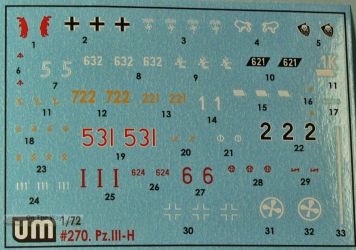
Instructions
The four page instruction sheet, is of the blown diagram type with
19 sub-assembly steps. On the front page there is a brief history
and data section, as well as a diagram of the contents. The fourth
page has three view diagrams, and decaling and painting instructions
for ten vehicles – all of them in Dunkelgrau. Humbrol codes
are suggested.
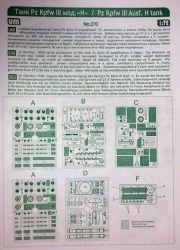 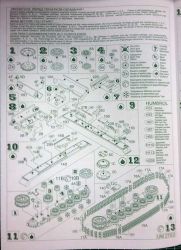 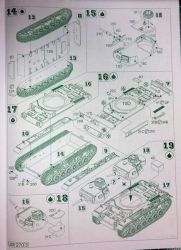 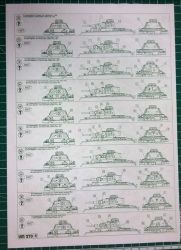
Scans
from Henk
of Holland used with permission.
Conclusion
This is not a flawless kit and it is not recommended for beginners.
On the other hand, it is dimensionally correct, has a lot of detail
and provides a host of spare parts. An averagely experienced modeler
will have no problem to create a beautiful and correct presentation
model. Furthermore, it is a very good basis for several conversions
(e.g. Munitionsschlepper, Bergepanzer, PanzerBefelswagen III, Tauchpanzer,
etc).
The sample
model was bought be myself.
References
- Achtung
Panzer Vol. 2
- Squadron/Signal
Armor in Action. Nr. 24
- The
Encyclopedia of German Tanks
- Peko
Books, Vols. 14 and 18
UM kits
can be purchased from

|